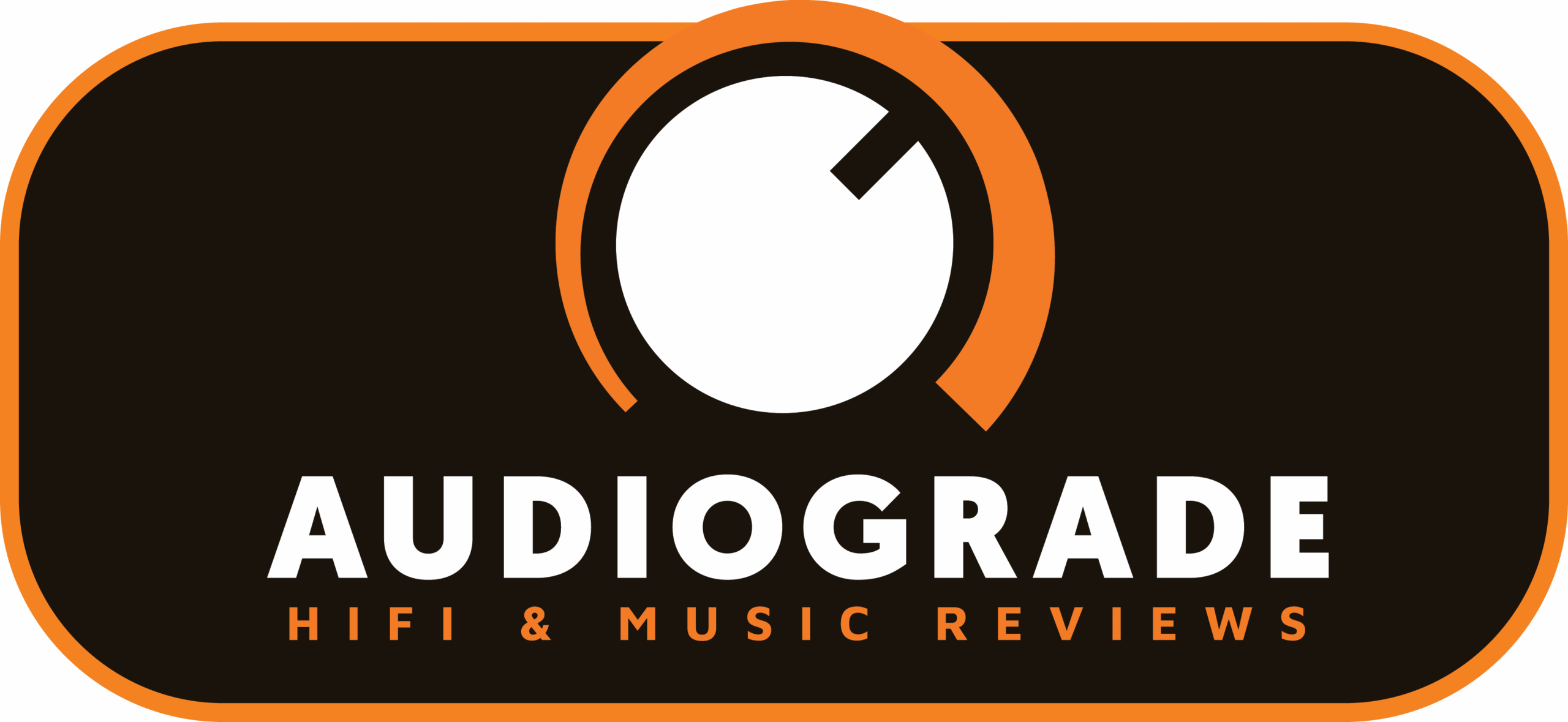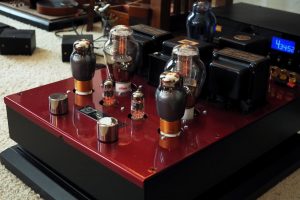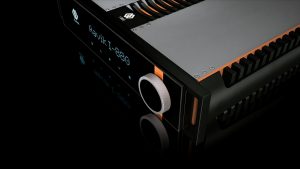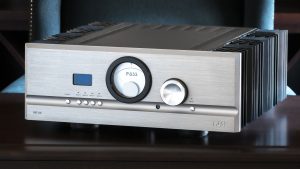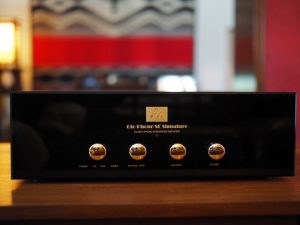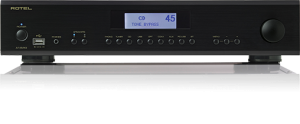It was clear from the moment I knew I would receive Kondo OnGaku amplifier for a review that I would also want to listen to it together with my friends from Krakow Sonic Society. These meetings give us not only a chance to meet, talk and listen to some music together but most of all to learn about different approaches to music reproduction. We don't necessarily agree with each of them but we surely learn from them. It also doesn't mean that we all "learn" the same things—each of us differs from the rest and when confronted with audio products we react differently on both, emotional, and rational level. Each of us uses his own experiences as reference what he hears and confronts it with his personal "absolute" sound.
This type of devices requires some time to settle in—mostly the output transformers do. Janusz has a complete system and there is no space for any other devices in his rack. So whenever we want to listen to some other components in his place we need to switch it with on of his devices, like in the case of Ayon CD-35, or use a separate rack, like we did with dCs Vivaldi.
The latter was the option we used for OnGaku. Audio Center Poland let us use their Naim Audio Fraim rack that gave us multiple configuration options. We placed the Ancient Audio Lektor Grand SE CD Player on a shelf. The Kondo amplifier was to be compared to Ancient Audio Silver Grand Mono. These are both Single Ended Triode low power amps, with highly acclaimed triodes in their output stages and with silver output transformers. They differ with type of output tubes, their number and power these deliver: Ancient Audio uses two 300Bs delivering 2 x 18 W, Kondo features 211 producing 2 x 27 W.
We decided to drive both amplifiers from the CD's variable output despite the fact, that Japanese amplifier is an integrated one. We set its volume level to get the same one, as delivered by Ancient Audio. To connect source with amps we used Siltech Triple Crown IC, and between amplifiers and Sonus faber Electa Amator (I) loudspeakers we used Siltech Double Crown cables. As for power, system featured Acrolink Mexcel 7N-PC9500 power cables and Ancient Audio Re-Generator power conditioner.
HOW WE LISTENED
The method we used for fairly simple as tube amplifiers have their requirements. We listened to Kondo first, then replaced drivers to learn if and how that affected the performance while listening to some recordings we used before and finally we listened to the same set of tracks in the same order on Ancient Audio.
Most of the previous 107 CSS Meetings looked quite the same. All participant always occupied the same favorite spot in the room throughout the whole time. It actually meant that one person was sitting in the sweet spot, two others had fairly good, although not as good, spots, and others had to agree for significant compromises. Because it's been going on for years we got used to it and learned to that into consideration when assessing the sound.
It's a good thing though to introduce some new elements every now and then so that the meetings would become just a routine. Routine is surely not a good thing for such activity. To be honest until now the level of emotions that are always incited is so high that we don't have to be afraid of a routine, but still some changes are necessary. It was Janusz who inspired me to think about some when he asked each of us to bring one album with him. We always do, but this time it was supposed to be a well thought-through choice instead of "what was handy at the moment" 🙂 I took that idea and added to it another—person who has brought particular recording should sit in the best spot when it is played. Before listening he is supposed to tell the rest something about his choice and suggest what we should look out for in this recording. I think that it worked quite well and I'd like us to continue this new tradition.
After each recording the person who brought it commented on what he'd heard and the rest of us added more comments. I decided I wouldn't moderate the meeting nor record it. Instead I asked every one to send me comments via email after they had a chance to think a bit about what they wanted to say and to confront their impression with their own systems. Also, I did not edit whatever I received from participants.
SOUND
Rysiek B.
Stan Getz/Jimmie Rowles, The Peacocks, Columbia/Sony Records SRCS 9186, "Super Bit Mapping" CD (1977/1997). Roku Pańskiego 2017 – Milestones
Thanks to many good people, and recently to two Wojteks, Szemis and Pacuła, a moved another step up the high end ladder. The KSS meeting no. 108 was another breakthrough for me. Let me remind you in random order our previous "breakthroughs":
- a head-to-head duel between "small" and "big" loudspeakers Sonus faber Minima Amator vs Guarnieri (Polish),
- a session with two-box CD Player Jadis JD1 MK II i JS1 MK III (Polish),
- a meeting with Japanese geniuses of Acoustic Revive and Accuphase,
- a meeting with cable masters from Siltech.
And now in Janusz' audio den we hosted an Emperor of high end audio, the Kondo OnGaku. Comparing this legendary Japanese amplifier with Ancient Audio's Silver Grand Mono seemed to unreasonable due to large price difference, but I was wrong. And yet, even knowing that many will not appreciate what I'm about to share, I will describe it the way I felt it.
Both amplifiers deliver performance close to my "ideal sound" and yet are very different from each other. Each of them clearly presented pros and cons of the other one. Here is what I heard during this session;
- Silver Grand Mono: absolutely pure, dynamic and tonally rich,
- Kondo OnGaku: majestic, well-balanced, holographic, musical and incredibly RICH – beautiful sounding,
- Silver Grand Mono: cold, detailed, well-balanced, with wide tonal range, fast and punctual,
- Kondo OnGaku: flowing, liquid, warm, slightly pumping up space, pastel and musical.
Allow me, please, to dream of the combined advantages of both amplifiers, as that would be my personal Holy Grail. Probably apart from fans of both Wojteks, Pacuła and Szemis, nobody else including both fantastic designers, will read the above. It's a shame as both of them could use it to improve their respective designs, just as another great master, Chopin, did with his works. All of the above mentioned listening sessions confirm my opinion that the high-end combines features of a sound that were present on each of these KSS meetings. The home high-end audio is a coherent combination of what microphones "hear", sound engineers create in studio and our system is able to play in our room with a live show performed in the best concert hall. In conclusion—it's a real shame that perfect audio components do not exist, but the search for them is so fascinating!
Jarek Waszczyszyn
ANCIENT AUDIO
Colorado String Quartet, Ethos Percussion Group, Grooving Classics, A Strings & Percussions Fest!, First Impression Music FIM XR24 044, XRCD24 (2006)
First of all, I would like to thank Janusz and both Wojteks for the meeting! There is no denying that Audio Note Kondo Ongaku is a legend, dream and an inspiration. My first tube amplifier Triode was based on Mr Kondo's design. Another amplifier that I made for Janusz featured a silver output transformer to get even closer to the legend. This was the beginning of our cooperation and the entrance into the world of high-end for Ancient Audio. With a hand on my heart, I can corroborate Mr. Wojtek Szemis's words—the cost of the amplifier is the result of the painstaking, time-consuming effort. I know because I make the same way the Silver Grand Mono, and I know what it takes to manually wind a transformer with silver wire. To a large extent, I feel Kondo-San's disciple. Even if a "cursed" one ...
So I came to the meeting truly excited. And as it often happens in a real life dreams and memories can not withstand facing reality.
Just two days in a row before this meeting I was listening to much cheaper but very dynamic sets. And the first impression after listening Ongaku I was very mediocre. I know Janusz system and Silver Grand Mono very well, even with Sonus faber monitors it delivers a tonally diversified, dynamic and spacial presentation. With the Ongaku tough it sounded monotonously, and chosen recording sounded poorly. I blamed it on a too short accommodation period (I listen to music using different system and my room has different acoustics). The worst thing was that somehow I could not get so ecstatic as some of my colleagues did, seemingly unconditionally. It happened to me a few times before that my hearing was accustomed to certain sonic features (exaggerations) in my previous systems so I had to consider a significant margin for error.
Hence, the moment of truth for me was when we switched to Ancient Audio amplifier. My ears proved to be OK. After this flat, little interesting sound of Ongaku I finally got what I'd missed - the dynamics, especially its differentiation, full tonal palette and proper space reproduction, meaning placement of instruments on the stage, the acoustics of the room and so on. When listening to the album Wiktor brought with him, now I heard the sound of cars outside the concert hall. This impression of space was so natural that only stopping playback made me realize what happened. The piano and saxophone on the The Peacocks sounded real, live, not as if they had been recorded 50 years ago. It's the same with Mark Knopfler's guitar. In both cases I felt real emotions.
But Ongaku in confrontation with the Silver Grand Mono also showed its strengths. The Japanese amplifier's performance was absolutely smooth. The Silver Grand sometimes presented things too sharply. If I only could add this incredible smoothness to my design!
After meeting, we spent a lot of time with Janusz talking because, as usually, emotions were in play for a long time after we turned the system off. It was a special evening. Janusz said during the meeting that if someone offered him Ongaku (without resale possibility!) in exchange for the Silver Grand Mono, he would not take such deal. I fully agree with him. As well as with another of his remarks. The Ongaku was the-state-of-art tube amplifier in the 1970s. It created a canon of uncompromising tube amplifier: directly heated triodes, no feedback loop, tube rectifier, silver wiring and transformers.
But for me it was just a starting point for my designs. The Ancient Audio design uses more advanced solutions (especially in the power supply) and components and materials (Teflon in capacitors and transformers, ultra-fast electrolytic capacitors). It's a new age, and a new quality arrived with it. Maybe not everyone likes that, because it shows a naked truth about everything that is recorded on the disc. But it is a goal to which I aspire as a constructor and that's why I admire dCs designers who achieved with their products even bigger realism in music than I did with my Lektor Grand. And something tells me that Hiroyasu Kondo was chasing the same goal.
Ongaku is, was and will be a symbol. The younger readers might need some historical background—in the 1970s a supremacy of transistors over tubes was undisputed and so was a primacy of mega-concerns over lone designers. The man who had a courage to oppose this state of affairs was a true giant.
Mariusz
Verdi Choruses, perf. by Carlo Franci, L'Accademia Di Santa Cecilia, Decca/Lasting Impression Music LIMXR24 018, XRCD24 (1964/2011)
First a few words about signal tubes comparison. The essential difference between these presentations was moving the front of the soundstage in the second variant clearly beyond the line of speakers. This way, a listener instead of participating in the spectacle became an observer. Secondly, there was a significant change in the tonal balance: there was less treble which was replaced with an emphasis in upper midrange. As usually in such a case, the sound becomes more substantial giving listener a greater comfort of witnessing an authentic energetic spectacle. This intrusive presentation of a triangle with standard tubes perhaps evokes audiophile emotions, but I had never seen a triangle in front of the orchestra, and so such presentation is definitely not for me.
For this meeting I chose the Verdi Choruses album, because it is one of the outstanding Decca releases that I know very well from the first LP release. This is a very complex music, which is especially challenging for a low power tube amplifier based systems. Generally speaking I was disappointed with this presentation considering the quality and price of all system components. I guess not all of them "liked" each other. I could even guess which one was a problem here.
Now Kondo vs. AA. AA seemed to have less problem driving SF monitors. It delivered higher and wider soundstage. Many will like that. On the other hand, the sound was brighter. A treble was clearly colored. I was surprised, because I knew the system well and I had never heard it before. I wouldn't accept such a defect not even in a budget system. The only explanation that comes to mind is the smog suspended over Krakow…
Since Kondo ensures a greater listening comfort, despite the temptation of a better developed soundstage, I choose Ongaku. However, I wouldn't name it my personal audiophile nirvana. Actually, only when listening to Mark Knopfler's guitar a hint of that musical magic appeared, which may be a reflection of the legend of the Ongaku.
Wiciu
Mascagni, Cavalleria Rusticana, perf. by Luciano Pavarotti, Decca 414-590-2, CD (1978/1988)
20 years had to pass from April 1973, when I first heard the concert version of Strange Kind of Woman in Sunday's Gaszyński and Witold Pograniczny broadcast, before on October 30th 1993 I finally heard it live in Zabrze. Most likely I heard about Ongaku for the first time in the mid-90s of the last century. I didn't have to wait that long to listen to it for the first time as I did for Deep Purple concert, because the owner of Zena Studio in Krakow, probably in autumn 1997, hosted some listening sessions of—even already back then—legendary amplifier. I remember that the presentation wasn't particularly impressive from my point of view.
And again, 20 years had to pass, for me to have another chance to listen to this amplifier, this time in a more friendly environment, during the 108. meeting of the Krakow Sonic Society. Before other participant came, the host played for me three CDs with piano concertos and a symphony by Wolfgang Amadeus Mozart. My first impression were not overly enthusiastic. I remembered the sound of our host's system well, so good spaciousness, purity and clarity of the presentation delivered by Ongaku did not impress me much. Moreover, especially when listening to the piano concertos (Curzon and Gould on Esoteric releases) the strings tutti seemed too sharp, far more than their natural sound.
Thus, when we finally officially started the meeting, I have to admit, I was rather skeptical. It seemed to me that the system highlights the upper midrange which is something I do not like it. It is often regarded as a sign of transparency, clarity of the system and it helps in the creation of spaciousness, but ultimately is make sound "glassy" and unnatural compared to the actual sound of acoustic instruments.
My opinion was overturned upside down, when the Ancient Audio CD player played CDs I knew. The first disc of this group was Jimmie Rowles with Stan Getz in the recording, in which the piano sounded very low, natural, without any annoying coloration, while the Getz' tenor sax sounded nothing short of lush. The second recording was a fragment of Mascagni's opera Cavalleria Rusticana. It was an album selected by me.
It was presented a little too quietly, but it sounded fantastic. It is a brilliant work of Decca engineers. The recording has a lot of space, but with Ongaku it became almost holographic. The realistic, attracting attention dialogues of female and male chorus plus the wonderful voice of the great Luciano Pavarotti—amazing. The third album, which sounded different than usually was a chorus from Il Trovatore by Verdi, which is often played during our meetings. The orchestra sounded without sharp coloration (also flutes), and my attention was attracted to remarkably clearly sounding triangle, as perhaps I'd never heard it before (interesting). The voices of the choir were balanced, properly sustained and engaging listener in action.
And finally the Dire Straits. During the last year I listened to their recordings played on several systems. They sound sharp and unpleasant. This time we played the Six Blade Knife from the band's first album released on the Platinum SHM-CD. Surprisingly, the playback lacked the annoying coloration of the upper band. No sibilance in leader's vocals so irritating in other playbacks. I do not know if ever before, and I have to mention that love this track, I'd realized that Pick Withers used brushes. The brushes massaged drums' membranes and Illsley's bass famously dictated the pulse of this song. The bass was particularly rich, smooth and sparkling.
After switching driver tubes in Ongaku its performance changed slightly. Already after two or three re-played discs it became evident that this magic holography disappeared, or at least its charm paled. In contrast, the vocals became more natural, as well as Getz' saxophone. It would take much more time to decide actual hierarchy—whether the first or the second setup was closer to the individual listener's preferences.
To summarize—the Kondo Ongaku enchanted me. From the position of a moderate skeptic, after listening to several tracks using two sets of tubes, I could only cry for more! This amp has incredible gift of seducing the listener. In the words of Richard S., it is like moving from a beautiful and peaceful hobbits' Shire to astonishing world of Elves. For me, it was like tasting ambrosia. Tempting and alluring. I would like to drink another and another glass of it. I have no idea how this feast would end; either with a crushing hangover or achieving an eternal nirvana. However, I'd be willing to take that risk, if such an opportunity presented itself and I would really love to be left alone with this amplifier and my record collection for a while. Maybe I could learn about it much more than I already do today. For now, however, learning the price of this device simply blew my mind.
Tomek
Agnes Obel, Citizen Of Glass, PIAS America PIASR905CDX, CD (2016)
I must honestly admit that evening with Ongaku for me was one of the most interesting ones I'd ever spent at Janusz'. The realism of the presentation of this amplifier on albums like Filia Praeclara with Divox Antiqua, or Les Ambassadeurs by Sabine Devieilhe Rameau was unprecedented. It offered me a whole new level of experience.
In direct comparison with the Ongaku the Ancient Audio was sharp, almost shrilling. Of course, it is an exaggerated version of what I heard, but in this confrontation, considering that we are talking here about the top-high-end devices, such was my impression. All recordings of classical music, vocal, non-amplified (as I call them) instruments, as the saying goes, sounded absolutely fantastic on Kondo.
A problem began with the modern sounds, for example, the album I brought with me this evening, the Agnes Obel Citizen Of Glass. Here clearly the Ongaku charm was gone, it was obvious that it was not made for this kind of music, at least with the standard set of tubes. I'd also heard the Dire Straits debut album on Platinum SHM-CD sounding better on other occasion, although the presentation proposed by the Ongaku was very good so I wouldn't reject it right away.
To sum it up let me repeat once again that this amplifier was able to present its class in the Janusz' "airtight", carefully matched system and charmed me greatly which I appreciated particularly considering that I'd never been really interested in SET amplifiers before.
Marcin
Dire Straits, Dire Straits, Vertigo/Universal Music LLC UICY-40008, Platinum SHM-CD (1978/2013)
As "my" song I chose the Six blade knife by Dire Straits. I know this number very well as I've listened to it numerous times on my own system as well as a few times on my colleagues reference sets. So I sat at the sweet spot to have a good listen to the details. I've listened to tracks selected by other participants before, but sitting at the side so now I expected some "cosmetic" effect on the sound. But what I heard from the speakers just crushed me. The softness of the drums, the timbre of the guitar and vocals sounded beautifully. So much color, richness, spacing I'd never heard in any system before. All these elements came nicely together to create a remarkable spectacle.
Plus this incredible spacing and imaging with every sound having its place. It was an amazing experience. All aspects of the presentation were a plus except for one, namely this get-up-and-go effect inherent to Dire Straits music somewhat decreased (because I can't say it disappeared completely). At some fragments it sounded somewhat less dynamic, as if they played it more "politely". But for me it was only a small nuance that was not able to disrupt this phenomenal experience I described above. For me, it was a true musical spectacle. I'd never heard anything like this before. I could spend the rest of my life with Ongaku. It is a pity that a man only has two kidneys.
Bartosz
Filia Praeclara, Ensemble Peregrina, Divox CDX-70603, CD (2008)
Unlike for (perhaps all) of colleagues from KSS meeting the Ongaku was not such an emotional experience for me. Yes, I was aware of its reputation I knew also the story of his designer's enough to know that here I was meeting on my way a true reference amplifier. But it wasn't enough for me to be overwhelmed even before listening session begun.
The session though, turned out to be very important experience for me for two reasons. First of all, because Ongaku is undoubtedly a remarkable amplifier. Its performance is well-thought-out, it squeezes from the accompanying components (source, loudspeakers, cables) everything they got, while the Japanese device seems to deliver the performance as if it was a piece of cake. The sound is very smooth, elegant and refined. The Ongaku is not trying to shock the listener with any particular quality of the sound, instead providing a very consistent presentation. I was even more impressed with the soundstaging. The holography was on the highest level; frankly, I do not remember hearing anything similar in this regard ever.
As mentioned above, the meeting with Ongaku was important for me for one more reason. This time a bit more personal. I'm not a particular fan of tubes. The qualities I am looking primarily for are what tubes can not provide: dynamics, energy, aggressiveness. However, I was curious to hear what the crème de la crème of a tube world has to offer in this regard. And although these aspects were presented at high level, as it turns out, some things are just too much for any tube device. A tube amplifier, even the best of the best, is obviously unable to provide as much energy in the sound as high-end transistor competitors (writing these words, I primarily mean the top-high-end Naim Statement). And the great, legendary Ongaku is no exception.
At the end I would like to dedicate a few words to the aspect of Japanese integrated amplifier that during the KSS meeting was not (I believe) not discussed. I'm talking about the phenomenal appearance of this device. The Ongaku just looks beautifully, using a lot of aesthetic solutions so beautifully described in a brilliant essay Praise of a Shadow by Jun'ichirō Tanizaki. This is a very "classic" amplifier in its appearance but it takes the "classic" to a level of perfection.
Wiktor Krzak
HAIKU-AUDIO
György Ligeti, Lontano, perf. by Wiener Philharmoniker, Claudio Abbado, Schott Music Corporation. Deutsche Grammophon, CD (1990)
The OnGaku is a legendary amplifier. A chance to listen to it is a memorable event that starts long before the button "Play" is pushed for the first time. Just its presence impresses those around it even in the silence when tubes warm up.
The first impression, which immediately attracts and dazzles, is this incredible spaciousness. After some time one comes to think whether it is too inflated, if what one hears was really captured in the recording. But maybe it was, but we couldn't hear it before?
The second thing that one realizes only after a certain time, but that turns out to be much more important, is the tonality. In this regard, Ongaku does something completely magical and unprecedented by any other device I've ever listened to. Namely, it presents tone and immediacy of the presentation of the original equipment from the 1930s and 1940s, but completing all of their shortcomings. The treble is crisp and vibrant, bass is strong and realistic, and the soundstaging staggering—all these things were unachievable for the old equipment. All these elements are often present in the performance of many good amplifiers, but never in conjunction with the hint of this magical vintage tone. The Ongaku is a time machine, but it doesn't take us back to the days of Stan Getz. It brings him to us, so that we can listen to him playing for us here and now, standing in front of us.
This amplifier becomes my reference. Not in regard to its particular internal design, not to its parameters, not even in terms of specific acoustic properties, control, or tonal balance, but in terms of the ability to portrait faithfully the emotions captured in the recording, a sense of the uniqueness of the spectacle, in which listener participates. I believe that Ongaku is not only an amplifier, but a true work of art.
Wojciech Szemis
SZEMIS AUDIO KONSULTANT
I would like to sincerely thank everyone in Krakow Sonic Society, and especially to Mr. Wojciech and Mr. Janusz, for inviting me to a very nice evening, I participate in a celebration, or actually, experiencing the phenomenon of living the emotions enchanted in the form of music. However, it was not only the music this Friday evening that was the essence of the meeting, but also the word that were spoken.
The limited time only allowed each participant to shortly express his opinion and therefore no unnecessary words were said. Perhaps the breath taking performance and beauty of music was also to blame. It seduced and uplifted us. I do not know whether the credit should go to Lektor CD Player, Ongaku or Electa Amator loudspeakers. No small part was certainly played by cables, too. I admit that I got carried away by the atmosphere of the meeting and now, as I write these words, it seems to me that the most interesting part this meeting was being together and savoring the sound of music. This being together consisted of remarkable personalities of all individual participants.
My part was to bring the Kondo On-Gaku amplifier, which is continuously produced from the early 1990s to the present time. This is the first and unique vacuum tube amplifier design featuring output transformers wound with silver wire. However, it not just the use of silver that carries the secret of this amplifier's performance, but also in the manner in which JAPANESE wire is drawn to obtain the molecular structure favorable to the sound and the dielectric used for it. Many designers have tried to copy the idea of silver transformers and simplicity of the Kondo's electrical circuits. We all know the effects of those efforts. All of them always referred results of their work to HOW Kondo-san did it. Why? Because no one was able to do it better. I know six, maybe seven designer of tube amplifiers, who all in their own way measure their achievements with those of Kondo-san, or (even!) try to compete with him. I am very happy about it—his engineering concepts are still an inspiration for many. I fully support them. I am always very interested to learn about their achievements.
It is unfortunate that there is only a small number of Kondo amplifier models which limits possibility of such meetings in the future. Although ... each of them is a realization of a separate artistic/engineering vision, offering a different approach to music for every music lover. And that's a lot!
Wojciech Pacuła
SUMMARY
Serge Gainsbourg, Histoire de melody Nelson, Mercury Records/Universal Music France 277 825 3, "Deluxe Edition" 2 x CD + DVD (1971/2011)
As you can see, the participants were divided into two groups—those for whom the qualities of Ancient Audio amplifier were more important and those who found Kondo unrivaled. This is completely normal situation. We are talking about top-high-end amplifiers. Both featuring tubes but used in different circuits. On this level even small changes compared with the personal "absolute sound" become "crucial".
And whoever believes that the better the audio components the more they are alike is dead wrong. On the surface, this is the case, because the high-end products do not share most problems of cheaper devices, which makes them somewhat "similar". In fact, however, only after getting rid of these problems the designer's personal beliefs / preferences start to play a key role. These do not concern qualities like treble or bass, that are important but not at this level, but the whole structure of the sound, how is it used to present music.
And so despite the fact that both these amplifiers are Single Ended Triodes, despite another fact they both are completely different from the overwhelming majority of today's amplifiers, the differences between them were quite significant and, so to speak, decisive. I agree with Jarek and Bartosz, who pointed to a much better leading edge presentation, dynamics and what Marcin called "get-up-and-go" presented by Ancient Audio. In a direct comparison one can hear that Kondo's band is somewhat narrower—the bass and treble are not as well extended as with AA, and its attack is smoother, as if it were polished. These are the elements that made the disc with a greater signal compression, requiring speed, because that's the only element that can reconstruct the "shape" of sounds, sounded in a more powerful, more vivid way with AA.
But it was also immediately clear that Jarek's the amplifier is bright and not that rich. I also wanted to describe its sound as "shrill" sounding, but Tomek beat me to it. This does not mean that it sounds poorly, or even bright. This means that it seemed so compared with Kondo. What is particularly interesting and significant because the Japanese amplifier had to play in a "closed" system, the AA amplifiers were voiced for.
It was also clear in this confrontation, that the Polish amplifier was hardly powerful enough to drive Sonus loudspeakers properly—which means my impression was quite opposite to that of Mariusz. I have no idea where this confusion came from. I agree with Wiktor, who off the record said that the Ancient Audio most likely had to work at its maximum output most of the time, meaning probably in a constant overdrive—hence, I assume, the shrillness of the sound some of us noticed. For the first time ever Janusz, who previously defended his speakers, honestly admitted that his loudspeakers were not able to show everything—Kondo forced them to give their best and it was still obvious that Sonus "held back" a lot of music, and they were, I have no doubt about it, the weakest link in this system, with either amplifier. Let me repeat—it was the first time when the limitation of these excellent speakers were so obvious. Even with the dCS system we did not have such observations.
Taking all this into account I had no doubt that Kondo and their product is the right proposal for me and it's the one that speaks directly to my musical soul. If its set of qualities included also the fast attack, dynamics and agility, this would be—as Rysiek said—the perfect amplifier. But I wouldn't want it to have the dynamics and attack of the AA but rather of Naim Statement mentioned by Bartosz. I truly respect the Polish amplifier, as well as its designer, Jarek. But for me this comparison proved, however, that when it comes to some qualities such as naturalness, smoothness and holography, the Polish amplifier simply can not match the level of Kondo. And I also learned that, even though a lot of things have changed since the 1970s, much has been improved, but there are still things that Kondo-san's disciples were not able to master as well as the legendary Japanese designer.
Therefore, if I only could, I would have stayed with Kondo Ongaku forever. Knowing its weaker sides, being aware of what could be done differently, maybe even in a better way. This would not matter for me, because the music with this phenomenal amplifier is so beautiful that I simply don't care, don't even remember about any shortcomings. But that's just my personal opinion and—it should be clear—one can choose differently, and this other choice will be equally binding as mine.

SYSTEM USED DURING THIS SESSION
- CD Player/preamplifier: Ancient Audio LEKTOR GRAND SE
- Power amplifier: Ancient Audio SILVER GRAND MONO
- Power conditioner: Ancient Audio Re-GENERATOR
- Loudspeakers: Sonus faber ELECTA AMATOR (Polish)
- Interconnect: Siltech TRIPLE CROWN
- Speaker cable: Siltech DOUBLE CROWN (bi-wire, 2 x 2,5 m)
- Power cables (used for all components): Acrolink MEXCEL 7N-PC9500
- Rack: Base
- CD Player: Naim Audio Fraim
- Anti-vibration accessories and room acoustic treatments: Acoustic Revive
- Wine: LocusVini.pl + participants
I'd like to thank Audio Center Poland and Mr Roman for loaning us the Naim Audio Fraim for this comparison!
Price (when reviewed): 1 090 000 Jen (around 100 000 EUR)
AUDIO NOTE Co., LTD.
MADE IN JAPAN
Meeting place:
KRAKÓW – JANUSZ
POLAND
Text: Wojciech Pacuła
Images: Wojciech Pacuła
Translation: Marek Dyba














